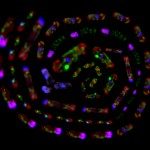Link to Pubmed [PMID] – 14685272
EMBO J. 2004 Jan;23(1):234-43
There is growing evidence that duplications have played a major role in eucaryotic genome evolution. Sequencing data revealed the presence of large duplicated regions in the genomes of many eucaryotic organisms, and comparative studies have suggested that duplication of large DNA segments has been a continuing process during evolution. However, little experimental data have been produced regarding this issue. Using a gene dosage assay for growth recovery in Saccharomyces cerevisiae, we demonstrate that a majority of the revertant strains (58%) resulted from the spontaneous duplication of large DNA segments, either intra- or interchromosomally, ranging from 41 to 655 kb in size. These events result in the concomitant duplication of dozens of genes and in some cases in the formation of chimeric open reading frames at the junction of the duplicated blocks. The types of sequences at the breakpoints as well as their superposition with the replication map suggest that spontaneous large segmental duplications result from replication accidents. Aneuploidization events or suppressor mutations that do not involve large-scale rearrangements accounted for the rest of the reversion events (in 26 and 16% of the strains, respectively).

